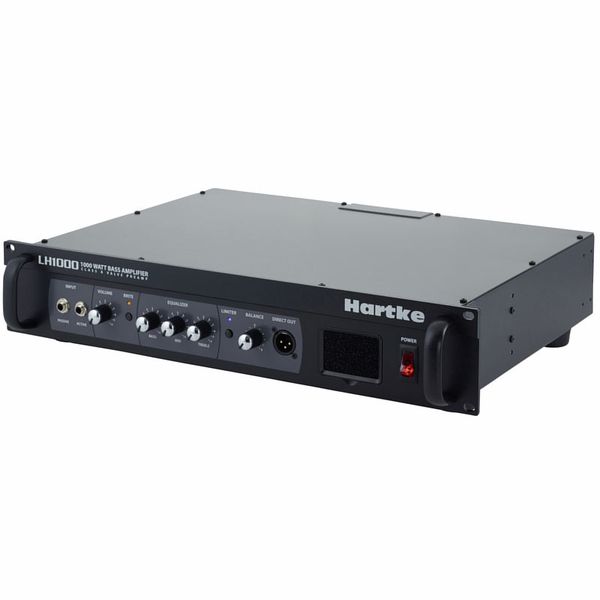The Hartke bass LH1000 is a big purchase as amplifiers go. So if you’re going to pay upwards of $650, what are you getting? Is this amp purchase sound shopping or should you login to another site, make an account, contact a new amp dealer and spend your money on other products?
In this review, we’ll take a closer look at the LH1000 to see if it’s really worth adding to your cart.
Features of LH1000 Hartke bass amp
The Hartke LH1000 bass amp is a powerful and versatile piece of equipment that offers a range of features for live performance and studio recording. With 1000 watts of power, this amp provides plenty of volume and headroom to handle any gig or session. Its rack-mountable design makes it easy to integrate into a larger setup, while its classic 12AX7 tube preamp circuitry ensures warm and responsive tone.
The LH1000 also includes bass, treble, and mid controls with a contour knob for shaping your sound, as well as a built-in limiter to prevent clipping and distortion at high volumes. Additionally, the effects loop allows you to integrate your favorite pedals or processors into your signal chain, while the XLR direct output with switchable pre/post EQ makes it easy to send your signal to a mixing console or recording interface.
Overall, if you’re looking for a powerful and versatile bass amp that can handle any situation, the LH1000 is definitely a product worth checking out.
Specs
Here are the physical dimensions and specs of the LH1000 bass amp:
Dimensions (H x W x D): 3.5″ x 19″ x 15.5″
Weight: 39 lbs
Power output: 1000 watts at 4 ohms, 700 watts at 8 ohms
Preamp circuitry: Class-A tube preamp with a 12AX7 tube
EQ controls: Bass, treble, mid, contour
Input impedance: 1M ohm
Effects loop impedance: Send -10dBu / Return +10dBu
Direct output impedance: Balanced XLR, pre/post EQ switchable
Overall, the Hartke LH1000 is a compact and relatively lightweight bass amp that packs a lot of power and features into a small package.
Amp & Circuitry
Its Class-A tube preamp circuitry provides warm and responsive tone, while its EQ controls and contour knob allow for easy sound shaping. And with its effects loop and direct output options, it’s easy to integrate the LH1000 into any setup or recording situation.
Which bass amplifier cabinets to pair with the LH1000
The Hartke LH1000 bass amp is a powerful and versatile amplifier that can be paired with a wide range of bass speaker cabinets to suit different playing styles and performance needs. However, there are a select few factors to consider when choosing a cabinet to pair with the LH1000.
Power & Impedance
Firstly, it’s important to choose a cabinet that can handle the power output of the LH1000. The amp delivers 1000 watts at 4 ohms or 700 watts at 8 ohms, so you’ll want to choose a cabinet with an appropriate power handling rating. Many high-quality bass cabinets will have a power handling rating of at least 500 watts RMS, which should be sufficient for most gigging situations.
Cab Configuration
Secondly, you’ll want to consider the size and configuration of the cabinet. Generally speaking, larger cabinets with more speakers will provide more low-end response and volume, while smaller cabinets may be more portable and focused on midrange frequencies. Additionally, some cabinets may feature specific speaker configurations like 4×10″ or 1×15″, which can affect their tone and projection.
Bass cabs to check out
With these factors in mind, some popular options for pairing with the Hartke LH1000 might include:
Hartke HyDrive cabinets: These cabinets feature hybrid paper/aluminum cone drivers that provide both warmth and articulation. They’re available in a range of sizes and configurations, including 2×10″, 4×10″, and 1×15″
Ampeg SVT cabinets: These classic bass cabs are known for their huge low-end response and punchy midrange. They’re available in various sizes and configurations, including 8×10″, 4×10″, and 1×15″.
Aguilar DB series cabinets: These high-end cabs are built using lightweight neodymium drivers for maximum portability without sacrificing tone. They’re available in various sizes and configurations, including 2×12″, 4×10″, and 1×15″.
Ultimately, the choice of bass cabinet will depend on your personal preferences as well as your playing style and performance needs. It’s always recommended to try out different combinations of amps and cabs before making a purchase to find the sound that works best for you.
Alternative Bass Amplifiers
After some time, you’ve consumed all the expert advice you can find, what should you do if you simply don’t want the Hartke model LH1000?
Luckily, there are other great bass amplifiers out there, and many can offer musicians very comparable features, quality and functionality for roughly the same price.
So what are these other options you should consider as part of your search?
Ampeg PF-800
This solid-state bass amp delivers 800 watts of power at 4 ohms or 400 watts at 8 ohms, making it a good match for most mid-sized venues. It features an onboard compressor and 3-band EQ, as well as a balanced direct output for recording or front-of-house mixing.
Gallien-Krueger MB Fusion 500
This hybrid bass amp combines tube and solid-state preamp circuitry to provide warm, responsive tone with plenty of headroom. It delivers 500 watts of power at 4 ohms or 350 watts at 8 ohms, and includes a built-in limiter and contour control for easy sound shaping.
TC Electronic BH250
This compact and lightweight bass amp delivers 250 watts of power at 4 ohms or 160 watts at 8 ohms, making it ideal for smaller gigs and rehearsals. It features TC Electronic’s TonePrint technology, which allows players to load custom effects settings into the amp using their smartphone.
Fender Rumble Stage/Studio
These digital bass amps from Fender offer a wide range of tonal options and built-in effects in addition to their solid-state power sections. The Rumble Studio delivers up to 40 watts of power through its single speaker, while the Rumble Stage can deliver up to 800 watts through an external cabinet.
Orange OB1-500
This hybrid bass amp from Orange combines solid-state power with an onboard Class-A/B preamp circuit featuring two gain stages for added tonal versatility. It delivers up to 500 watts of power at either 4 or 8 ohms, and includes an active EQ section with parametric mids.
All of these amps offer different features and tonal characteristics compared to the Hartke LH1000, so it’s important to try out several options before making a decision on which one is right for you.
How much does a Hartke lh1000 weigh?
The weight is 39lbs or roughly 17.7kg.
What is the best brand of bass amp?
This depends on a lot of factors such as tone, category of amp, what type of gear one prefers, nevermind how easy it is to ship from gig to gig, what kind of savings are offered as part of purchasing deals and all the other things that go into shaping your own taste.
That being said, popular stock in many bass shops for many months has included gear made by Hartke, Markbass, Aguilar, Ampeg, Ashdown, Trace Elliot and Peavey to name a few.
Of course, if there are any questions about any names we’ve missed, feel free to comment with them below! We aim to reply within one business day although that’s not always possible.
What is the best bass amp for recording?
The best bass amp for recording ultimately depends on your personal preferences and needs. Some popular options include the Ampeg SVT-3PRO, the Gallien-Krueger MB Fusion 800, and the Markbass Little Mark Tube. It’s important to consider factors such as tone, power output, and connectivity options when selecting an amp for recording purposes.
Do you need an amp for Ubass?
Ideally, yes. They can’t produce a great deal of volume on their own despite technically being acoustic instruments.
How do you match a bass head to a cabinet?
To match a bass head to a cabinet, you need to consider the power output of the head and the power handling rating of the cabinet. Make sure that the amp’s output impedance matches the cabinet’s input impedance as well.
What should I look for in a bass cabinet?
When looking for a bass cabinet, you should consider factors such as size, configuration, power handling, and speaker type. Think about your playing style and performance needs to determine which features will be most important for your setup.
What are the best bass cabs?
The best bass cabs depend on factors such as your playing style, preferred tone, and budget. Some popular options include the Ampeg SVT-810E, the Hartke HyDrive HD410, and the Markbass Standard 104HF. It’s important to consider factors such as power handling capacity, speaker configuration, and overall build quality when selecting a bass cab.
How big of a bass cab do I need?
The size of a bass cab you need depends on various factors such as the size of the venue you’re playing in and your personal preferences. Generally speaking, larger cabs with more speakers will provide more volume and low-end response than smaller cabs. However, larger cabs can also be heavier and more difficult to transport. It’s important to find a balance between portability and performance when selecting a bass cab size.









Leave a Reply